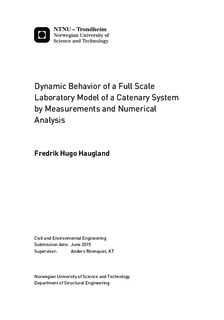Dynamic Behavior of a Full Scale Laboratory Model of a Catenary System by Measurements and Numerical Analysis
Master thesis
Permanent lenke
http://hdl.handle.net/11250/2351443Utgivelsesdato
2015Metadata
Vis full innførselSamlinger
Sammendrag
The behavior of railway systems, in particular the overhead contact line (OCL), is consideredin this thesis. The modelling of such systems with the use of the finite element method areimportant to carry out, both to determine the systems static and dynamic behavior. Thedynamic behavior is primarily related to the relationship between the overhead contact lineand the pantograph, which should ensure stable currents to the train.
The aim for this study was to make a numerical model of a simplified, laboratory versionof an OCL. The laboratory model consisted of two spans approximately 15m long, with asupport in the middle. The finite element modelling was carried out both by the use ofPython scripting, and by the use of Abaqus/CAE version 6.14 as numerical software.
Laboratory measurements were conducted, primarily to validate the numerical model,but also to compare the behavior of the laboratory model in relation to existing OCLs. The results of the measurements indicated that the laboratory model was approximately 3-4 stifferin the vertical direction, compared to existing OCLs.
The numerical model was compared with the measurements conducted in the laboratory,which comparison primarily was related to natural frequencies and the variation ofelasticity along the span. Comparison between the results obtained in the laboratory andthe numerical results showed the same trend both due to natural frequency and elasticity,but the numerical model was created both less stiff and more dense than the laboratorymodel. Despite the latter, the numerical model was regarded as plausible in comparison tothe laboratory model, and it was further used in two parameter studies.The parameter studies performed were related to:
1. The development of the first vertical natural frequency, for varied tension in the contactandmessenger wire.2. The effect of removing droppers from the system, in relation to the first and the secondvertical natural frequency.
The results obtained in these parameter studies showed first of all that the development ofthe first natural frequency was dependent on whether it was the contact or messenger wirethat was applied the highest magnitude of tension.
Further, the removal of a dropper in the model seemed to have more effect on the firstnatural frequency, than the second natural frequency.
In future work, it is recommended that natural frequencies of higher modes than the firstand the second are investigated. The development of the first natural frequency of existingOCLs should be compared with the results obtained in the parameter study made in thisthesis, to further validate the conclusions made.
